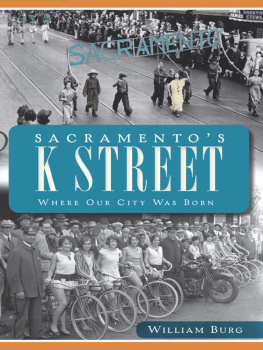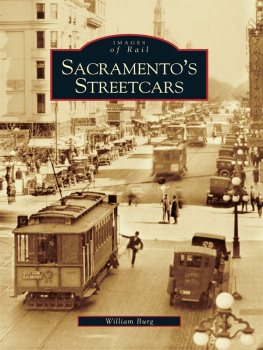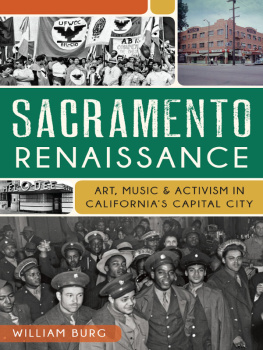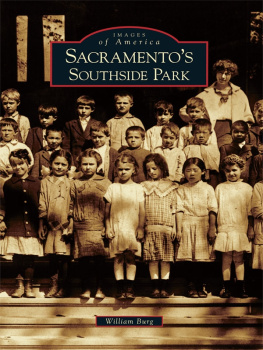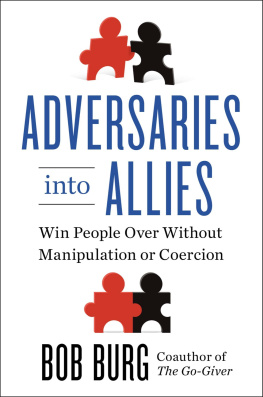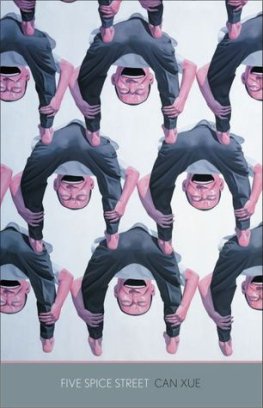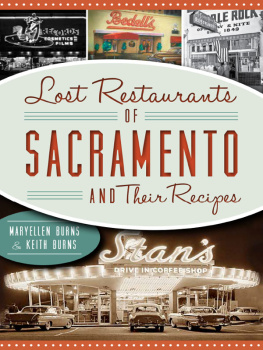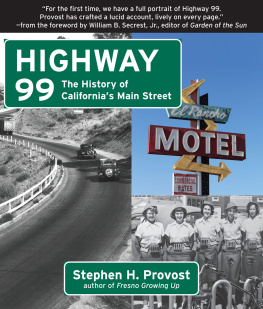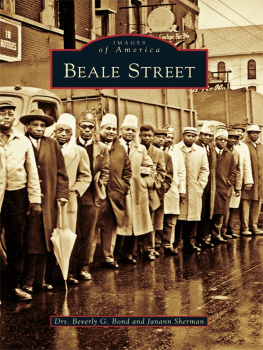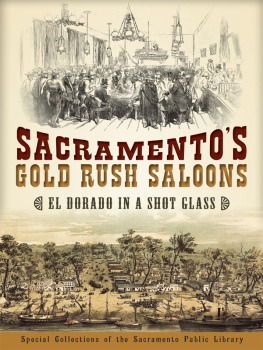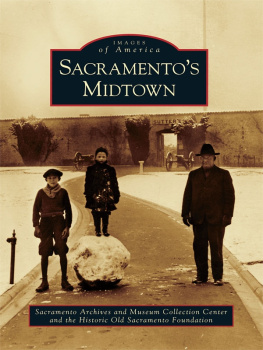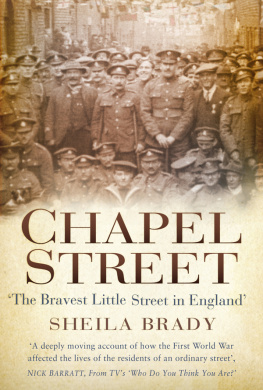
Published by The History Press
Charleston, SC 29403
www.historypress.net
Copyright 2012 by William Burg
All rights reserved
Cover image courtesy of the Center for Sacramento History.
First published 2012
e-book edition 2012
ISBN 978.1.61423.587.3
print ISBN 978.1.60949.425.4
Library of Congress CIP data applied for.
Notice: The information in this book is true and complete to the best of our knowledge. It is offered without guarantee on the part of the author or The History Press. The author and The History Press disclaim all liability in connection with the use of this book.
All rights reserved. No part of this book may be reproduced or transmitted in any form whatsoever without prior written permission from the publisher except in the case of brief quotations embodied in critical articles and reviews.
This book is dedicated to the memory of my grandmothers, Margie Signore and Blanche DeVita, and in memory of Douglas Yee, Sacramento historian and great-great-grandson of Sacramento pioneer Yee Fung Chung.
CONTENTS
ACKNOWLEDGEMENTS
Most of the photographs in this book come from the Center for Sacramento History. Archivists Rebecca Crowther and Patricia Johnson were invaluable guides to the centers enormous photo collections. Sacramentos Central Library and its Sacramento Room were an equally valuable source for government documents, newspaper articles and out-of-print autobiographies that captured untold aspects of K Streets story. To librarians like Tom Tolley, James Scott and Amanda Graham, I owe a debt of gratitude and library late fees. The Western Railway Museum provided photographs of Sacramentos interurbans and streetcars.
Some material came from unpublished Sacramento State University masters theses, including the work of Barbara Lagomarsino, Clarence Caesar, Nathan Hallam, Robert Briggs and Brian Roberts. Graduate work often explores otherwise poorly documented areas of local history, but the end product is hidden in university basements. These works deserve greater review and study and are an underutilized resource for local history writers.
Sacramento States connection with local history goes back to the universitys founding. Many early faculty were charter members of Sacramento County Historical Society (SCHS). SCHS publications, such as Golden Notes, Sacramento History Journal and full-length book titles, approach local history from an academic perspective. Serving as an SCHS board member introduced me to an esteemed community of Sacramento historians and a closet full of digest-sized visits into Sacramentos past.
Many good friends shared their memories of K Street, including George Raya, Joy Gee, Leo and Maryellen Burns-Dabhagian, Mike Munson, Manuel Viera, Herbert Yee and Scott Soriano. Keith Burns, Dennis Newhall and Doug Taggart shared photos and documents from their private collections.
INTRODUCTION
J Street was a way out of town. K Street you always strolled.
Maryellen Burns-Dabhagian
The scope of this book stretches, like K Street, from the birth of Sacramento at the rivers edge to the demise of the theater that gave Alhambra Boulevard its name. The hotels, theaters, department stores, restaurants, dance halls, apartments, churches, offices, grocers and homes of K Street are all aspects of city culture. Immigrants and migrants came to cities like Sacramento, bringing diverse traditions. Through shared experiences like shopping, attending vaudeville shows and movies, parades and festivals, dancing, dining and working together, an American popular culture and urban identity formed. Some attempted to reinforce American values in place of foreign traditions, but urban life in cities like Sacramento was inevitably shaped by the cultures of its people.
K Street begins at the Sacramento River and ends at Thirty-First Street, Sacramentos original city limit. Unlike J Street (the road out of town to the goldfields) or M Street/Capitol Avenue (the route over the river and to Folsom), K Street is a street that functions solely within Sacramentos urban core. Modern K Street is divided into segments. The westernmost segment is Old Sacramento, which stretches from the river to Second Street, where K Street is cut off from the rest of the city by Interstate 5 except for an underground walkway. The next is the semi-enclosed Downtown Plaza between Fourth and Seventh Streets and the former pedestrian mall between Seventh and Thirteenth, ending at the Sacramento Convention Center that physically blocks K Street. The third is part of what is now called Midtown, between Fifteenth Street and Business Route 80 at Twenty-Ninth Street. The final segment is the short stretch between Thirtieth Street and Alhambra Boulevard, where a fountain and a few palm trees are the only physical reminders of the Alhambra Theatre, on the edge of the East Sacramento neighborhood.

This 1936 map shows Sacramentos central city and streetcar lines. J and K Streets were both main streets, but J Street continued out of town while K Street stopped at the city limits. Authors collection.
Some of these barriers are technically permeable to traffic, but they create mental boundaries that are hard to cross. Old Sacramento receives hundreds of thousands of visitors every year, but many never visit the remainder of downtown Sacramento across Interstate 5. Downtown and midtown Sacramento, despite their historic association as two halves of an urban whole, became divided as the business district expanded, and this expansion depopulated entire neighborhoods downtown. Residents of the central city sometimes treat the space between the highways and rivers as an island, refusing to leave the grid unless necessary. The boundary of Business Route 80 at Twenty-Ninth Street is equally daunting for many residents of Greater Sacramento, who seldom (or never) visit the central city. These barriers are not unique. They are common in most large American cities and bear the legacy of national trends in urban renewal, highway construction and suburban expansion.
The disconnection of K Street into unequal parts symbolizes the disconnection of Sacramentos urban history and its downtown neighborhoods from the pastoral legacy promoted by Sacramentos business community and Progressive era politicians. The story of K Street is the story of the conflict between these two very different histories. Redevelopment and suburbanization destroyed most of the physical evidence of Sacramentos industrial, immigrant and urban heritage, but enough remains in photographs, oral histories, newspaper accounts and government reports to provide an intriguing but incomplete look into the lives of the thousands who lived near K Street.
Because this story spans multiple lifetimes across all social classes, it is presented as a collection of short narratives, biographies, quotes and essays about the people, institutions, traditions and edifices found along K Streetall connected by the themes of struggle and celebration and their locations along the street where Sacramento was born. For many Sacramentans, their opinion of K Street reflects their opinion of Sacramento as a whole, whether in aspiration, nostalgia, appreciation or disgust. K Street was and is a place for transportation, entertainment, commerce, recreation, celebration, labor, residence or just a leisurely stroll. It is a street for the flneur, those who walk in a city in order to experience it, not just to reach a specific destination. K Streets urban legacy is the shared territory of the
Next page
